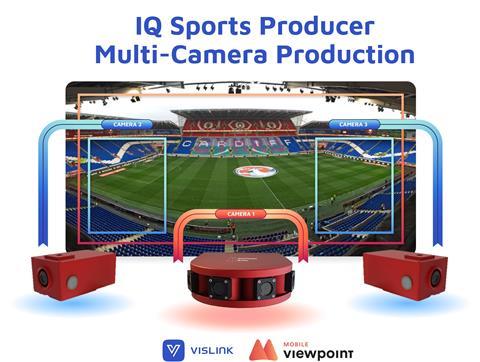From an initial emphasis on automating tasks such as caption generation and subtitling, it’s increasingly evident that AI is poised to revolutionise numerous areas of media production and distribution, writes David Davies.
At the start of 2021, IBC 365 took an in-depth look at the increasing use of Artificial Intelligence (AI) and Machine Learning (ML) to streamline access services, including the creation of subtitles and captions, and simplify the transcription of interviews and other content for internal use.

The speed at which the trend was accelerating was concisely summarised by Anupama Anantharaman, vice-president product management at Interra Systems: “We see broadcasters using ML/ML-based platforms to automatically generate missing captions, check on caption and audio alignments, ensure the accuracy of captions, and maintain correct punctuations in captions.”
- Discover more about the growth of AI in broadcast
Eighteen months later and the use of these technologies to deliver a host of essential services is now embedded in many broadcast organisations – and no wonder, when their accuracy (already frequently north of 90%) is being improved all the time. But now there are plentiful signs that AI is increasingly and effectively being applied to other areas of content creation – from audio dubbing to image recognition and camera tracking.
Michel Bais is managing director of Mobile Viewpoint at Vislink Technologies, which acquired the former company in August 2021 and has recently introduced a number of AI-enabled solutions.

“I do see AI crossing over into more and more areas of production, with a lot of companies undertaking research to see how it can be used to make different tasks more efficient,” he says. “So, for example, we already see AI being employed a great deal for image recognition, as well as automatic tracking of cameras. It’s clear that we are at the start of a very interesting chapter.”
Sports summaries & player recognition
From 4K to immersive audio, sport remains an enthusiastic early adopter of new technologies – and AI is no exception. Bais confirms that the ongoing expansion of sports services is fuelling a great deal of innovation in this area, with AI-backed solutions helping broadcasters to cover more events without adding unduly to their cost-base.
“It’s not uncommon these days for rights contracts to require that you stream a huge number of matches. Therefore, a lot of production companies are looking to see how they can make that happen by using lower-cost technologies that include some element of AI,” he says.
Specific examples include the automatic production of short-form content, summarising goals and other “key points” in sports events for posting and sharing online. Historically, says Bais, “a lot of [these] summaries have been pretty basic. But with AI, you have the opportunity to automatically recognise the goal, clip that out, and have all the reaction to it as well. That can be presented to the editor right away and made available shortly afterwards. So, for that content, I see there being a lot of potential for AI.”
Vislink itself is gradually evolving a considerable portfolio of AI solutions, including IQ Sports Producer, a live sports production and streaming solution that provides high-quality, economical video coverage for professional and grass-roots sports. The company has also developed an AI-driven studio content production system called vPilot, which enables pro-grade productions to be created without a camera operator or director team.

As well as opening up potential new revenue streams by allowing a wider range of events to be covered, there is the chance for multi-camera AI production to deliver a “richer and more immersive” production than might be achieved using a basic single camera set-up. With the AI studio production system, adds Bais, there is the opportunity for “engagement-building elements such as expert opinion and match analysis to be added to programmes. This helps content rights holders expand viewer counts and engagement levels, and deliver better returns on event coverage.”
- Watch the webinar: The enhanced TV sports experience
This type of content is also suitable for distribution across multiple platforms, including social media, OTT, CDN and live playout for broadcast TV. As well as typically being used for sports-related interviews, there is also scope for this kind of solution to be deployed in TV talk shows. “You can use a system like this to go live without a director or camera person, with the [image recognition technology] making it possible to position the cameras accurately, ensuring you don’t get shots of empty chairs and so on. So yes, we do hear of people pitching the use of AI systems for those sorts of shows.”
Slow start then exponential growth
Media services provider Globecast is another early pioneer of AI in media. In fact, as far back as 2018, Shakunt Malhotra – managing director of Globecast Asia – identified 10 target applications ranging from quality checking (QC) to sophisticated metadata creation, editing and compliance in a blog for the Globecast website. Four years on, Malhotra remains as enthusiastic as ever about AI in broadcast, while indicating that it will take some time to realise its full potential.

“New vistas are opening every day,” Malhotra says. “We have been experimenting with the use of AI from QC to the creation of highlights. Recently, we have been working on captions and virtual advertisements. However, I am yet to see wider deployment of AI as it should be.” Instead, we should look to another current industry trend to gain an idea of its probable trajectory. “I believe it will be like cloud, which had a slow start and then exponential growth.”
Not surprisingly, the use of AI to streamline the delivery of advertisements in different contexts is a particular target of industry activity. “Virtualised advertising is another area where AI makes perfect sense,” says Malhotra, adding that “we have been working with our customers [to enable] billboard replacement in the stadium. With the help of AI it can be more dynamic.”
The technology is also being used by online platforms to identify advertisement break structures, which can help ensure “a smooth transition to advertisements rather than the ‘choppy insertions’ that [can occur at present].”
In addition, there are plenty of applications in content distribution, such as predictive error detection. Using AI in distribution networks to “identify patterns that can lead to incidents is going to help in proper network bandwidth management in CDNs as well as processing power management in the cloud.” AI detection of colour bars and clocks in live video recordings or legacy conversions – allowing these images to be removed in transcoding ahead of further OTT distribution – is another use case.
Regarding Globecast’s own aspirations in AI, Malhotra says the company’s strategy is currently focused on image/audio recognition and pattern recognition. “It’s well-recognised that the media supply chain will benefit from this. For instance, text to speech and image recognition are already used for media asset management.”

The implementation of effective standards invariably accelerates the adoption of new technologies, and it remains to be seen if there is an appetite to apply standards to AI in the way that is seemingly about to happen in metadata management. Meanwhile, it’s a surer bet that we will see a continued refinement of AI-based technologies so that they can deliver the kind of rock-solid reliability craved by broadcast engineers.
Humans are not 100% accurate and neither is AI, indicates Malhotra, “but it has to come closer [than it is at present]. For that to happen, more data has to be added to ML so that there is a wide variety of use cases [that can feed back into AI implementations]. Once we have that quintessential information it will be possible to get closer to that idea of perfection broadcast operation heads like to see.”
AI is seeing rapid adoption in broadcast environments, as it offers substantial cost and efficiency benefits. Find out more about AI in broadcast.
























No comments yet